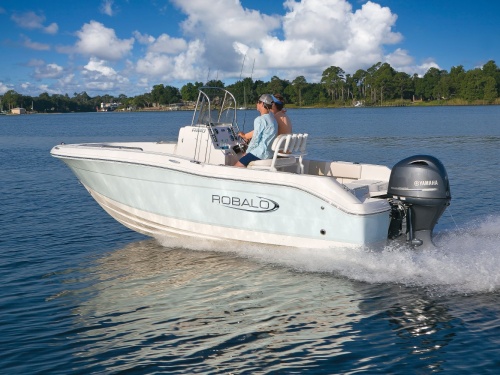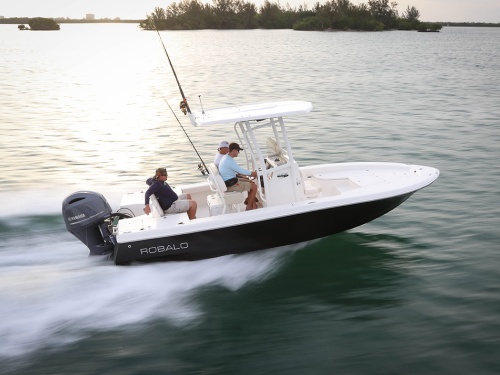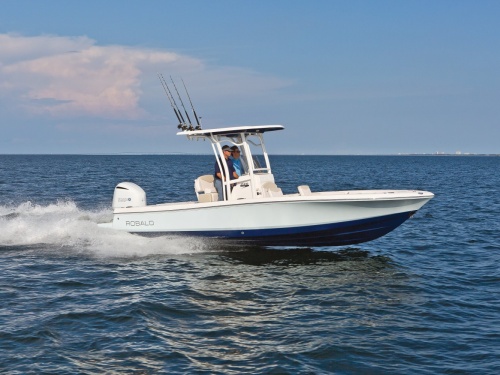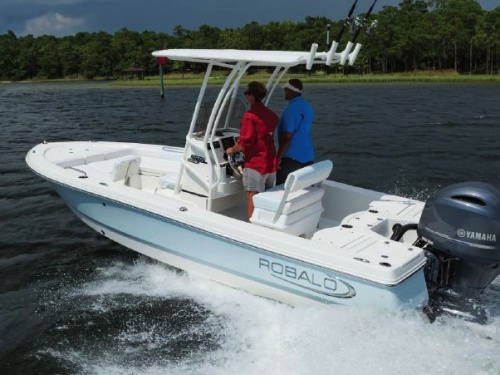Access More Boat Tests
Already have an account? Login
Robalo 206 Cayman (2019-)
1 x 150-hp Yamaha 150XA
Brief Summary
The 206 Cayman is designed to be a premium-quality bay boat boat/engine/trailer package at a reasonable price. That means she has amenities and has incorporated the latest design thinking for this class of vessel. With an outboard-up draft of 10" (25 cm) she can be used in the same places that every other bay boat, flats boat or skiff can be used.
She has some marked advantages over many smaller, older boats. By designing in lots of bow flare she is intended to be as dry as possible in a low-freeboard bay boat. With three livewells, a Kevlar keel and a rated engine capacity of 200-hp, the 206 Cayman offers features that a "move-up" angler has probably wanted for years.
Key Features
- Forward console seat/bolster with aerated 15 gal. (56.78 L) livewell
- 15 gal. aft livewell with LED lighting
- 6 vertical rod holder storage
- Aft jump seats with folding backrests
- Lighted high-speed compass
- Yamaha digital gauges
- Stainless steel bow and stern eyes
- Trailer includes 14" (35.56 cm) tires with aluminum rims
Test Results
| RPM | MPH | Knots | GPH | MPG | NMPG | STAT. MILE | NM | dBa |
|---|---|---|---|---|---|---|---|---|
| 600 | 3.2 | 2.7 | 0.45 | 7 | 6.09 | 315 | 274 | 69 |
| 1000 | 4.6 | 4 | 0.7 | 6.5 | 5.65 | 293 | 254 | 66 |
| 1500 | 6.2 | 5.4 | 1.25 | 4.96 | 4.31 | 223 | 194 | 69 |
| 2000 | 7.4 | 6.4 | 2.1 | 3.5 | 3.04 | 158 | 137 | 72 |
| 2500 | 8.5 | 7.4 | 3.4 | 2.5 | 2.17 | 113 | 98 | 78 |
| 3000 | 18.6 | 16.1 | 4.15 | 4.47 | 3.89 | 201 | 175 | 83 |
| 3500 | 24.7 | 21.4 | 5.1 | 4.83 | 4.2 | 218 | 189 | 84 |
| 4000 | 30.1 | 26.1 | 6.55 | 4.59 | 3.99 | 206 | 180 | 88 |
| 4500 | 34.8 | 30.3 | 8.85 | 3.93 | 3.42 | 177 | 154 | 88 |
| 5000 | 39.1 | 34 | 10.55 | 3.7 | 3.22 | 167 | 145 | 91 |
| 5500 | 43.4 | 37.7 | 14.25 | 3.04 | 2.65 | 137 | 119 | 95 |
| 5900 | 45.4 | 39.4 | 15.85 | 2.86 | 2.49 | 129 | 112 | 100 |
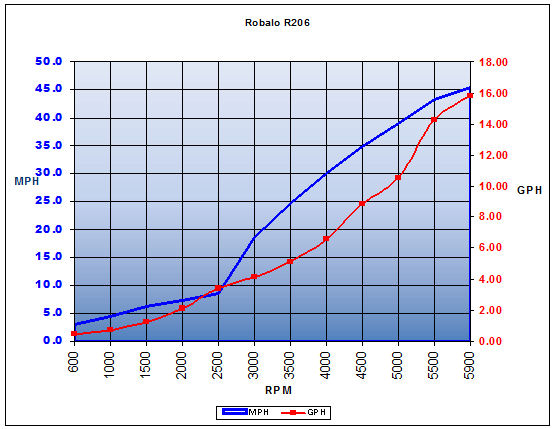
Specifications
| Length Overall |
20' 6" 6.25 m |
|---|---|
| Beam |
8' 2.44 m |
| Dry Weight |
2,700 lbs. 1,225 kg w/ eng |
| Tested Weight |
3,460 lbs. 1,569 kg |
| Draft |
10" 0.25 m |
| Deadrise/Transom | 15 deg. |
| Max Headroom | open |
| Bridge Clearance |
7' 10" 2.39 m |
| Fuel Capacity |
50 gal. 189 L |
| Total Weight |
3,460 lbs. 1,569 kg |
Acceleration Times & Conditions
| Time to Plane | 3.2 sec. |
|---|---|
| 0 to 30 | 8.2 sec. |
| Props | 2 persons, full fuel, full water, 50 lbs of gear |
| Load | 89 deg., 78 humid.; wind: 5-10 mph; seas: light chop |
Engine Options
| Tested Engine |
1 x 150-hp Yamaha 150XA |
|---|---|
| Opt. Power |
1 x 115-hp Yamaha 4-stroke F115XA 1 x 150-hp Yamaha 4-stroke F150XA 1 x 200-hp Yamaha 4-stroke F200XB |
Warranty
| Hull Warranty Extended | 10-year limited |
|---|
Captain's Report
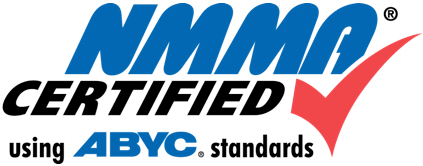 Learn More
Learn More
Watch Our Video
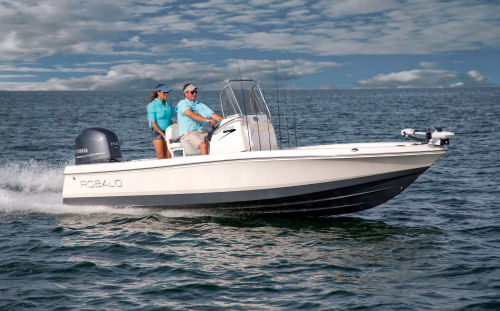
Overview
The 206 Cayman is designed to be a premium-quality bay boat/engine/trailer package at a reasonable price. That means she has amenities and has incorporated the latest design thinking for this class of vessel. With an outboard-up draft of 10" (25 cm) she can be used in the same places that every other bay boat, flats boat, or skiff can be used. But she has some marked advantages over many smaller, older boats. By designing in lots of bow flare she is intended to be as dry as possible in a low-freeboard bay boat. With three livewells, a Kevlar keel, and a rated engine capacity of 200-hp, the 206 Cayman offers features that a "move-up" angler has probably wanted for years.
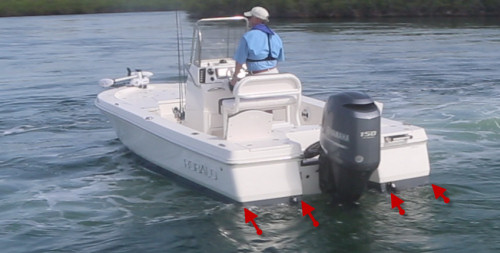
Distinguishing Features
- Three livewells, all on the centerline.
- Kevlar laminated into the keel for hard grounding protection.
- Reasonable, nationally advertised price.
- Pronounced bow flare for a drier ride.
- Extended V-plane hull for improved performance.
Major Features
- Aluminum frame around the acrylic windshield
- Storage for 5-gallon bucket and net
- Standard 54-quart cooler under leaning post
- Hydraulic steering for standard engine
- Self-bailing cockpit
- Yamaha digital gauges
- Fuel anti-theft device
- Tandem axle trailer with disc brakes
- Brass high-speed livewell thru-hull pick-up
- 10-year hull warranty
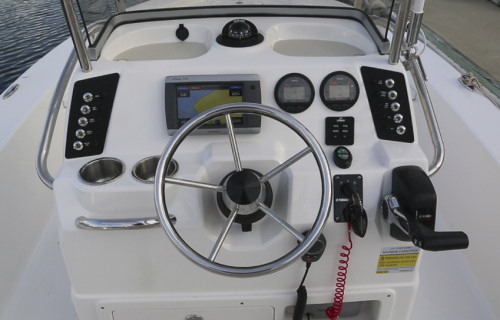
The Center Console
Innovation.
The center console unit itself is a work of art with its numerous molded seatbacks and reliefs that add style and utility. There are two storage pans in the top of the console on either side of the standard compass. They have rubber pads in the bottom and are self-draining. We usually see a flat surface here or at best a shallow indentation for a cellphone. This is a good design and we wouldn't hesitate to make the pans even deeper next year.
Steering.
The steering wheel is canted at about a 45-degree angle and the hub is recessed into the console, which saves space. Bay Star hydraulic is standard and tilt steering is an option. Beyond the wheel is the real estate for the moving map display or nav screen, which will be partially obscured by the wheel. Getting the tilt-wheel option and moving the screen to the left should solve this minor problem.
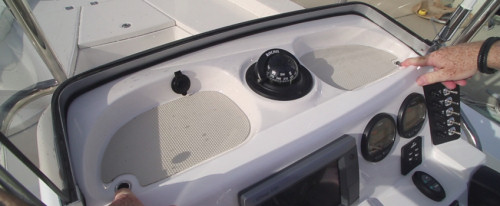
Other Console Details.
To port and starboard are stainless steel accessory switches that are compact and not subject to UV degradation as are plastic ones. The VHF radio fits into a compartment below knee level in the console, which means the captain will have to bend over to switch channels. A locking glove box is just to the left of it. Below is a cutout that serves as a footrest when using the leaning post.
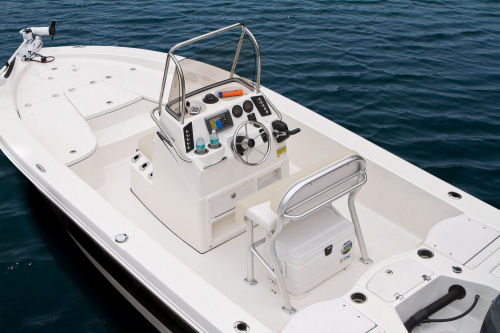
Windscreen Arrangement.
Robalo has done a good job of putting ss railings and hand holds around the console. As guests typically like to stand on the side decks adjacent to the console when underway, these handholds are in the right place. We like the handhold to the port of the steering wheel. It provides a place for the captain to hold on with the left hand when things get rough and take some strain off the wheel. The throttle is set at a typically high, nearly vertical angle. The acrylic windshield is protected by a massive ss railing that should both provide lots of places to hold on, but will also protect the windshield if someone should fall into it. It appears to be one of the strongest we have seen in class.
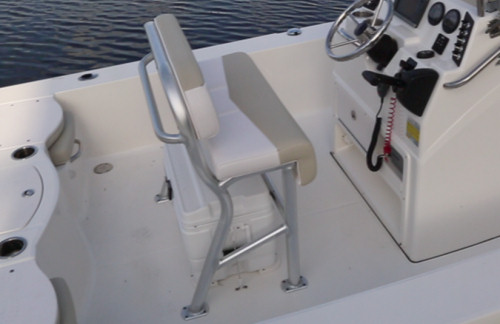
Leaning Post.
The leaning post on the 206 Cayman has an aluminum frame and the seat itself has a composite substructure with multi-density foam under the two-tone UV-resistant vinyl. Under is a 56-qt. Igloo cooler that is held down with bungee cord and kept in place with four acrylic chocks. The seat's frame is secured to the deck with 16 fasteners. This arrangement and these materials are fairly typical for boats in this class.
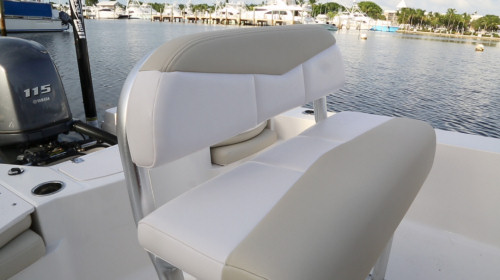
. A leaning post cover is $279.
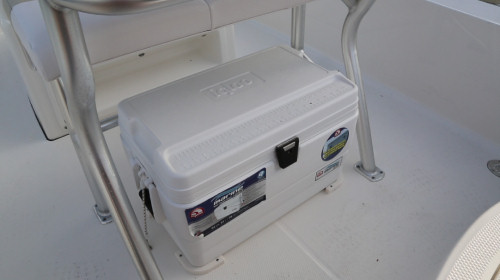
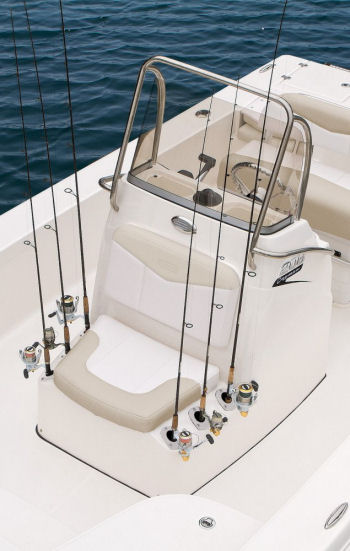
Console Seat/Livewell.
The forward part of the console molding has a good-sized seat for one plus a cushioned backrest. To the sides are holders for six vertical rods. Under the seat is an 18-gallon livewell, which has an aerated head unit and an overboard drain.
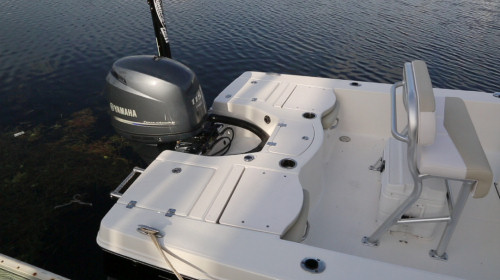
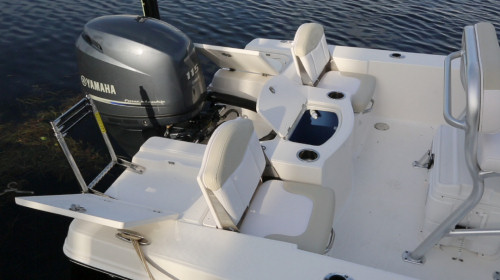
The Stern
The stern casting platform has been carefully engineered and built to eliminate any lips or protrusions that might cause an angler to trip. That is perhaps the most important aspect of the 206 Cayman's design here. The two jump seats fold down and rest on solid stops, not relying on their hinges or the cushion to support the lid. That is one important aspect of this casting deck that is not readily apparent. When the seats are down there is one even -- and solid -- surface covered with a diamond tread pattern molded in for non-skid.
Bucket List.
In the port quarter under a hatch rests a 5-gallon bucket. This location is an ideal place for keeping a fish net, something that is popular in the Carolinas and Georgia area. To starboard under a hatch is a three-step re-boarding ladder. The saltwater washdown bib seen in the outboard well is optional ($143). Just forward of the outboard well on the centerline is a 15-gallon livewell with LED lighting, blue gel coat, rounded corners and aerator. The livewell is covered by an acrylic hatch with latch.
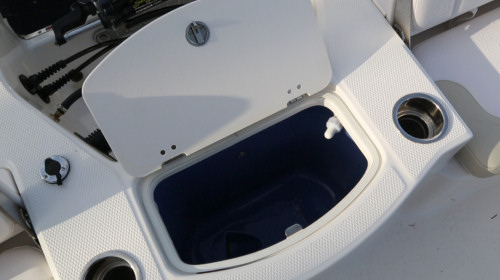
The Bow
The casting platform in the bow is much larger than the one aft. But like it, the surface has been carefully built to be perfectly flat and not to have any lips, latches or hinges protruding that might cause an angler to trip. There is a forward hatch that is large enough to hold an 8-lb. Danforth-type anchor and plenty of line. Just forward of this hatch is a plug that has been pre-wired to handle a trolling motor. An optional Minn-Kota trolling motor is offered as an option for $1,644.
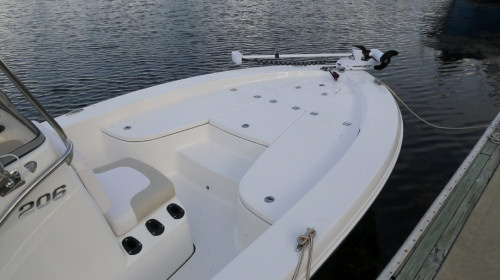
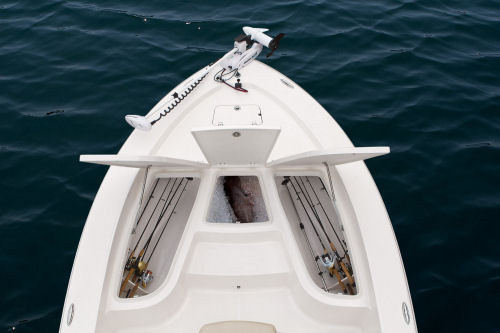
Versatile Compartments.
Port and starboard are two large, locking compartments that can be used for a number of purposes. They are the largest storage compartments on the boat and they are somewhat unusual because they are hinged forward and open from the back.
Rod Lockers/Fishboxes.
When at rest the two forward compartments can be used to store fishing rods. Because they are self-draining, they can be used as fishboxes when fishing. When cruising around, one can be used as a cooler if more space is needed beyond the 54-quart cooler aft. More likely they will be used for storage of things like life vests, fish nets and other equipment.
More Features.
We like the step up from the deck to the bow platform. There, on the centerline, under an RTM hatch is a compartment that can serve a number of purposes. It can be a third livewell if needed or a storage compartment for Plano tackle boxes. In any case, it is self-draining. All three livewells are insulated with LED lights, rounded corners and aeration.
Performance
The Robalo 206 Cayman has an LOA of 20’6” (6.25 m), a beam of 8’ (2.43 m), and a draft of 12” (30.5 cm). With an empty weight of 2,700 lbs. (1,225 kg), 20 gallons (76 L) of fuel, 2 people and test power onboard we had an estimated test weight of 3,460 lbs. (1,569 kg). With a Yamaha 150 XA outboard turning a 14 ¼ x 18 3-bladed prop we reached a top speed at 5900 rpm of 45.4 mph. At that speed, we were burning 15.85 gph giving us a range of 129 miles. Best cruise came in at 3500 rpm and 24.7 mph. That speed reduced the fuel burn to only 5.1 gph and the 206 Cayman could keep that up for 218 miles and 8 hours and 48 minutes while still maintaining a 10% reserve.
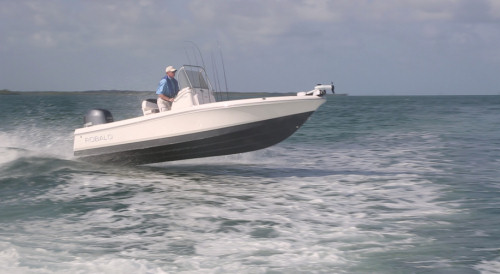
We reached planing speed in 3.2 seconds, accelerated to 20 mph in 5.3 seconds, and continued through 30 mph in 8.2 seconds.
Handling
However, it was the handling characteristics that were most surprising about this boat. Shallow draft bay boats are designed to run in shallow water and tuck into a little hidey-hole that other boats simply cannot reach. That typically does not make a boat that crosses over into any offshore conditions. But this 206 Cayman is without a doubt the exception to the rule. In our test, we had to make a long run over several miles to open water in some significant chop and it gave us a great idea of this boat’s performance capabilities when the going gets rough.
Those capabilities were, in a word, exhilarating. The faster we went into the seas the more she caught air and remained flat, performing a gentle re-entry with the prop somehow managing to remain in the water. There was no pounding, and spray was thrown well out to the sides presenting a surprisingly dry ride. And in following seas, we were able to open up to speed even more without any tendency toward stuffing the bow nor were any of the following ways pushing the stern to the sides. We tracked straight and true, skipping across one wave after another.
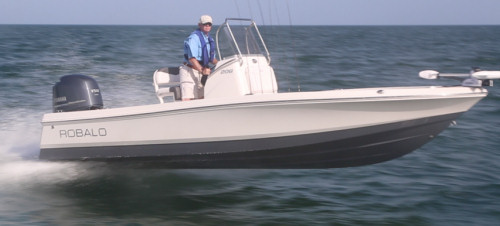
Bottom Shape
The 206 Cayman has a warped V bottom that flattens into 15 degrees of deadrise at the transom. The deadrise of the Robalo 206 Cayman is right in the middle of the range that we usually see in these types of boats. Typically the deadrise of bay boats ranges from about 10 degrees at the flattish end to 19 degrees at the modified deep-V end of the spectrum. The 206 Cayman's bottom deadrise is right in the middle.
At the Extremes:
A flattish bottom is more efficient in terms of speed and fuel consumption and also more stable, but can be uncomfortable in a chop and down-right bone-jarring when it is sloppy at high speeds. A nearly deep-V bottom provides a more cushioned ride at speed in choppy or sloppy conditions, but is harder to push and therefore theoretically is not as efficient, uses more fuel and won't go as fast. It can also be more rolly at rest.
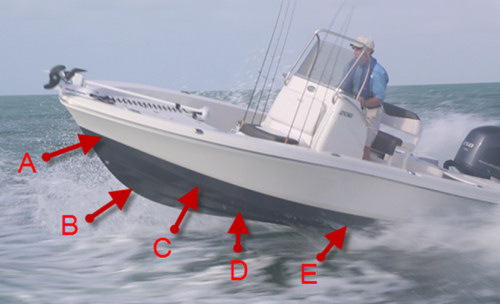
A Compromise?
Robalo has chosen a middle course. And in that, it is not alone, as we know of at least three other brands of bay boats that also has a bottom with 15 degrees of deadrise at the transom. Is it comfortable enough? Does the boat go fast enough and is she fuel efficient enough?
See the Movie.
The answer to all of these questions can be graphically seen in our video of this boat which Captain Steve — the test captain and the person who should know — narrates some slow-mo video and explains what it felt like going through some waves and catching air on test day.
Extended Bottom.
The 206 Cayman has Robalo's "extended-V plane" bottom which the builder says lets her get on plane faster with a lower bow rise, and means she can stay on plane at a slightly lower speed than she would otherwise. Our tests of the 206 Cayman with time to plane and fuel consumption at best cruise speaks for itself. While we have not been able to compare the efficacy of this design concept on bay boats, we have tested enough of Chaparrals, which use the same concept, to have a near-certainty that this design does keep the promise.
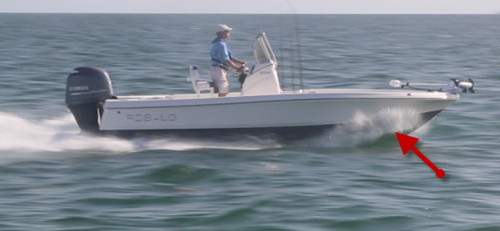
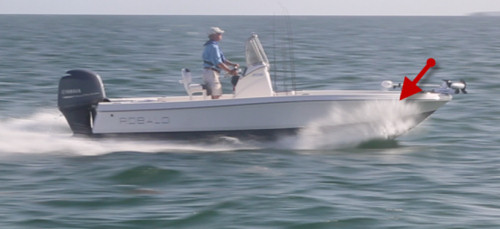
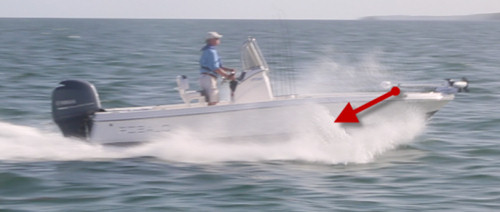
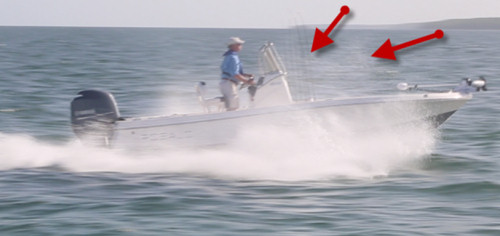
Bow Flare.
As noted, the 206 Cayman has more bow flare than many bay boats, particularly older ones, and that together with her hard chine carried forward and up the stem, work well together to keep the boat dry. The chine knocks down the waves and throws water out and the topside flare forward stops the spray from going in the cockpit. Obviously, if it is blowing fresh, no amount of chine and flare will keep a boat dry.
Engine Options
The 206 Cayman comes standard with a Yamaha F115XA with a mechanical linkage. It has a 25" shaft. Two options are available: a Yamaha F150XA for $33,165 plus dealer prep and a Yamaha F200XA for $36,590 plus dealer prep. Both of the options come with a 25" shaft and mechanical steering.
Other Options
As we look down the options list we see a few things that we think many boaters might want, such as —
- Aluminum T-top with canvas and 4 rod holders — $2,971
- Raw water washdown — $143
- Trim tabs — $831
- Sound system, FM radio/USB/MP3 port — $278
- Fold-down windscreen for garage storage — $456
The Price
"Nationally Advertised Price."
Add to that the fact that Robalo is a sister company to Chaparral and one can see the engineering fire-power and component-sourcing muscle that has been brought to bear on the 206 Cayman. It is for that reason that Robalo is offering the 206 Cayman at a "nationally advertised" package price of $30,595, including a Yamaha F115XB outboard, a tandem-axle trailer, and dealer prep fees.
Observations
The Robalo 206 Cayman measures pretty much in the middle of boats in her class as far as weight and beam go. She has a higher freeboard and a deeper cockpit than many, however. We have not compared amenities, but we'd say that about the only thing on our short options list above that we sometimes find as standard on other boats in class is the raw water washdown feature. On the other hand, we can't think of any other bay boat that has three livewells, forward-hinged fishboxes and such a robust rail around the windscreen.

